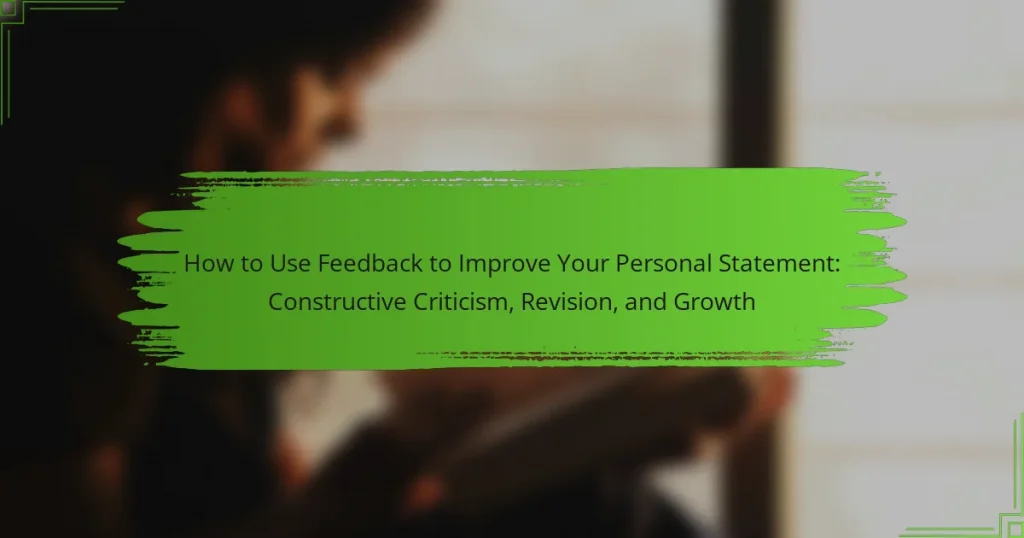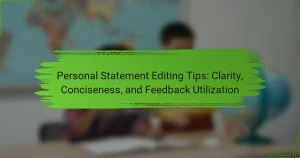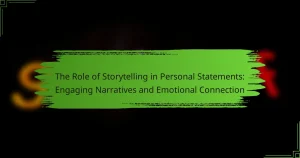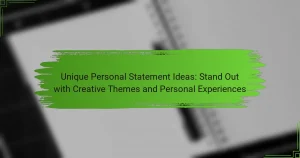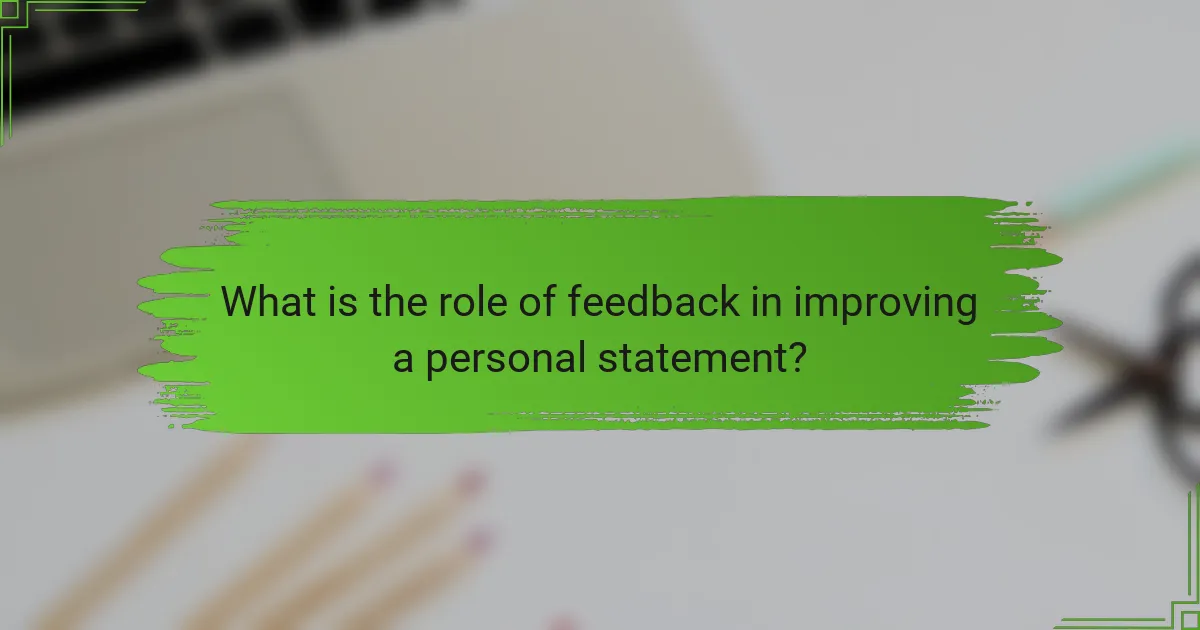
What is the role of feedback in improving a personal statement?
Feedback plays a crucial role in improving a personal statement. It provides insights into clarity, coherence, and impact. Constructive criticism helps identify strengths and weaknesses in writing. Reviewers can highlight areas that may need more detail or better examples. This external perspective often reveals blind spots the writer may overlook. Feedback also encourages revisions that enhance overall quality. Engaging with feedback fosters growth and helps refine the writer’s voice. Research shows that iterative feedback processes significantly enhance writing skills and outcomes.
How can constructive criticism enhance my personal statement?
Constructive criticism enhances a personal statement by providing targeted feedback on content and structure. It identifies areas that require clarification or improvement. This feedback can highlight strengths and weaknesses in the narrative. Specific suggestions can lead to more compelling language and clearer arguments. Research shows that incorporating feedback leads to higher quality writing. A study by the National Writing Project found that peer reviews significantly improve writing skills. Engaging with constructive criticism fosters a growth mindset. This process ultimately results in a more polished and effective personal statement.
What types of feedback are most beneficial for personal statements?
Constructive feedback is most beneficial for personal statements. This type of feedback focuses on specific areas for improvement. It highlights strengths and weaknesses in content and structure. Peer reviews provide fresh perspectives and can identify unclear sections. Professional feedback from mentors or advisors offers expert insights. They can guide tone and style adjustments. Feedback that encourages reflection helps writers articulate their motivations. Lastly, feedback that includes examples of effective personal statements can serve as a valuable reference.
How can I differentiate between helpful and unhelpful feedback?
Helpful feedback is specific, actionable, and constructive. It provides clear suggestions for improvement. Unhelpful feedback is vague, general, or overly critical without guidance. Helpful feedback often focuses on particular sections or elements of the work. It may include examples or references to support its claims. Unhelpful feedback may express opinions without context or reasoning. Research shows that specific feedback leads to better outcomes in writing (Hattie & Timperley, 2007). Therefore, evaluating the specificity and constructiveness of feedback can help differentiate its usefulness.
Why is revision important after receiving feedback?
Revision is important after receiving feedback because it enhances the quality of the work. Feedback provides insights into areas that need improvement. By revising, individuals can address specific concerns raised by reviewers. This process leads to clearer communication of ideas. It also demonstrates responsiveness to constructive criticism. Studies show that revision can significantly improve writing quality. For instance, research by Graham and Perin (2007) indicates that revision strategies lead to better writing outcomes. Ultimately, revision ensures that the final product is polished and effective.
What specific areas should I focus on during revision?
Focus on clarity, structure, and content relevance during revision. Clarity ensures your ideas are easily understood. Structure involves organizing your statement logically. Content relevance means aligning your experiences with the program’s requirements. Additionally, pay attention to grammar and punctuation. This prevents distractions from your main message. Lastly, incorporate feedback effectively to enhance your statement. Research shows that revisions improve overall quality significantly.
How can I effectively incorporate feedback into my revisions?
To effectively incorporate feedback into your revisions, first, categorize the feedback you receive. Identify which comments are constructive and actionable. Next, prioritize the feedback based on its relevance to your main message. Focus on significant areas that impact clarity and coherence.
Then, revise your content systematically, addressing one piece of feedback at a time. Make specific changes based on the suggestions provided. After making revisions, review your work to ensure that the changes enhance the overall quality.
Finally, consider seeking additional feedback on your revised draft to confirm improvements. This iterative process helps refine your personal statement effectively.
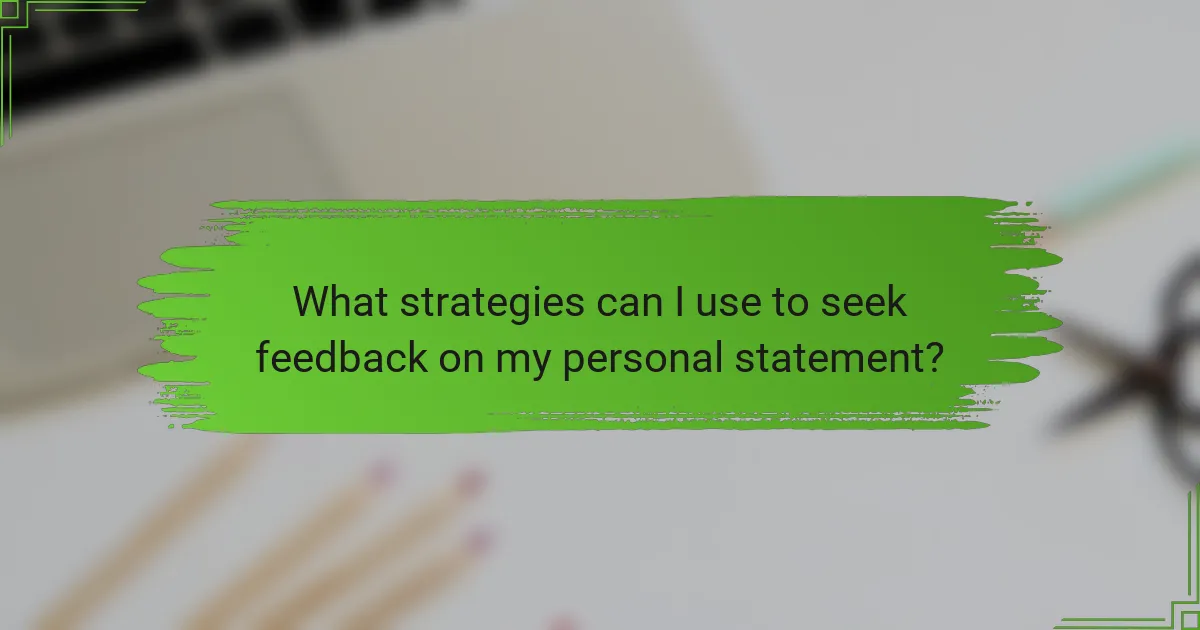
What strategies can I use to seek feedback on my personal statement?
Seek feedback on your personal statement by engaging multiple reviewers. Ask teachers, mentors, or peers for their insights. Utilize online writing platforms for broader perspectives. Join writing groups or workshops for collaborative feedback. Schedule one-on-one sessions with professionals in your field for expert advice. Provide specific questions to reviewers to guide their feedback. Incorporate their suggestions into your revisions. This approach enhances clarity and effectiveness in your personal statement.
Who should I ask for feedback on my personal statement?
Ask trusted individuals who can provide constructive feedback on your personal statement. Ideal candidates include teachers or professors familiar with your academic work. They can offer insights on clarity and structure. Peers who have successfully written personal statements can also provide valuable perspectives. Additionally, consider seeking feedback from mentors or professionals in your field of interest. They can help align your statement with industry standards. Lastly, writing centers or academic advisors often have resources and expertise to enhance your statement.
What qualities should I look for in a feedback provider?
A feedback provider should possess expertise, constructiveness, and reliability. Expertise ensures that the provider has relevant knowledge in the subject matter. Constructiveness means the feedback is specific, actionable, and aimed at improvement. Reliability indicates that the provider is consistent and trustworthy in their evaluations.
For instance, a qualified teacher or professional in your field can offer valuable insights based on their experience. Constructive feedback can highlight both strengths and weaknesses, guiding revisions effectively. A reliable provider will deliver timely feedback, helping you stay on track with your personal statement revisions.
How can I prepare my personal statement for feedback sessions?
To prepare your personal statement for feedback sessions, first, review the guidelines for the feedback session. Understand the specific areas where feedback is needed. Next, organize your statement clearly with distinct sections. This includes an introduction, body, and conclusion. Highlight key points that you want feedback on. Ensure your statement reflects your personal voice and experiences. Finally, be open to criticism and ready to make revisions based on the feedback received. This approach allows for constructive criticism, leading to growth in your writing.
How can I create a structured feedback process?
To create a structured feedback process, begin by defining clear objectives for the feedback. Identify what aspects of the personal statement need improvement. Develop a set of criteria that outlines specific areas to focus on, such as clarity, coherence, and engagement. Gather feedback from diverse sources, including peers, mentors, and professionals in the field. Schedule regular feedback sessions to ensure consistent input over time. Encourage constructive criticism by fostering an open environment where suggestions are welcomed. Document the feedback received and categorize it according to the established criteria. Finally, review and implement the feedback in a systematic manner to refine the personal statement effectively.
What steps should I follow to organize feedback effectively?
To organize feedback effectively, start by categorizing the feedback into specific themes. Identify common areas of concern or praise in the feedback received. Next, prioritize the feedback based on its relevance and importance to your personal statement. Create a structured outline that incorporates the feedback into different sections of your statement. This helps visualize where changes are needed. Then, summarize the feedback for clarity, noting key points for each category. Finally, implement the changes systematically, focusing on one section at a time to ensure thorough revision. Organizing feedback in this manner enhances clarity and improves the overall quality of your personal statement.
How can I track changes and improvements over time?
To track changes and improvements over time, maintain a detailed journal of your revisions. Document each version of your personal statement along with feedback received. Compare these versions to identify specific changes made. Set measurable goals for each revision, such as clarity or word count. Utilize a checklist to ensure all feedback is addressed in subsequent drafts. Regularly review your progress against these goals to assess improvement. Analyzing these revisions will highlight areas of growth and effectiveness in your writing.

What are common pitfalls to avoid when using feedback?
Common pitfalls to avoid when using feedback include ignoring the source of the feedback. Feedback from unqualified individuals may lead to poor revisions. Another pitfall is taking feedback personally. Personal feelings can cloud judgment and hinder growth. Additionally, failing to seek clarification can result in misunderstandings. Clear communication ensures accurate interpretation of feedback. Overloading on feedback from multiple sources can create confusion. It’s important to prioritize and synthesize feedback effectively. Lastly, neglecting to implement feedback is a critical mistake. Actionable steps based on feedback are essential for improvement.
How can I manage conflicting feedback from different sources?
To manage conflicting feedback from different sources, prioritize the feedback based on relevance and credibility. Identify the source of each piece of feedback. Consider the expertise and experience of the individual providing the feedback. Evaluate the context in which the feedback was given. Look for common themes or suggestions across the feedback. Analyze how each piece aligns with your goals for the personal statement. Make decisions that reflect your voice while incorporating valuable insights. Document your choices to ensure clarity in your revisions.
What strategies can help me stay true to my voice while revising?
To stay true to your voice while revising, focus on maintaining your unique style and perspective. Regularly refer back to your original draft and identify key phrases that reflect your voice. Use these phrases as anchors during revision. Additionally, read your work aloud to hear how it sounds and ensure it aligns with your intended tone. Seek feedback specifically on voice from trusted peers. Their insights can help you recognize areas where your voice may be diluted. Finally, take breaks between revisions to return with fresh eyes, allowing you to better identify your authentic voice.
What best practices should I follow when revising my personal statement?
Revise your personal statement by focusing on clarity, coherence, and conciseness. Begin by reading your statement aloud to catch awkward phrasing. Ensure each paragraph has a clear main idea and supports your overall narrative. Use specific examples to illustrate your points. Remove any redundant or irrelevant information to strengthen your message. Seek feedback from trusted peers or mentors for diverse perspectives. Incorporate their suggestions thoughtfully while maintaining your voice. Finally, proofread for grammatical errors and typos to enhance professionalism. These practices will improve the quality and impact of your personal statement.
How can I ensure my revisions align with my goals and intentions?
To ensure your revisions align with your goals and intentions, start by clearly defining your objectives. Identify what you want to convey in your personal statement. Write down your main messages and themes. Use these as a reference point during revisions. Evaluate each revision against your defined goals. Ask if the changes enhance clarity and purpose. Seek feedback from trusted peers or mentors. They can provide insights on alignment with your intentions. Regularly revisit your goals as you revise. This keeps your focus sharp and intentions clear.
What final checks should I perform before submitting my personal statement?
Perform final checks on your personal statement by reviewing grammar and spelling. Ensure that the content flows logically and clearly. Confirm that you have addressed all prompt questions. Verify that your statement adheres to any specified word limits. Check for consistency in tone and style throughout the document. Ensure that your personal experiences are relevant and compelling. Finally, have someone else read it for an additional perspective. These steps enhance clarity and professionalism, making your statement more effective.
The main entity of the article is the process of using feedback to enhance a personal statement. The article outlines the critical role of constructive criticism in identifying strengths and weaknesses, fostering growth, and refining the writer’s voice. It details effective strategies for seeking and incorporating feedback, differentiating between helpful and unhelpful critiques, and emphasizes the importance of revision in improving clarity and coherence. Additionally, it provides best practices for aligning revisions with personal goals and offers final checks to ensure the submission is polished and impactful.
